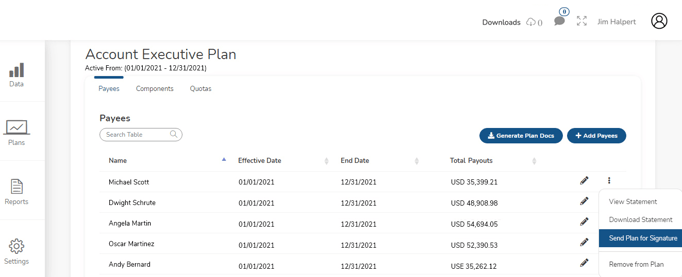Sales commission agreements are often hastily put together and an extremely tedious part of administering sales comp plans. Here, we break down the key points that you need to know so that you have clear, fair, and legally enforceable comp plans.
Disclaimer: The information presented in this post does not constitute legal advice. Consult a real lawyer, not a blog post, to know how these terms impact your company.
The Basics of Sales Commission Agreements
Sales commission agreements need to cover a few key elements.
First and foremost, comp plan agreements need to be in writing and signed
The commission structure must first be outlined in a written agreement and then signed and copied by all parties. Additionally, a sales commission agreement needs to be distributed and signed before the plan goes into effect.
You need to spell out how a rep can achieve their On-Target Earnings
It’s important that the agreement clearly spells out exactly how the sales rep will earn their commission. When you’re making offers to your team, you’re indicating the variable comp they will earn in their role. Your agreement needs to show what those outcomes are.
Explain how the commission will be calculated and paid
Provide clarity on metrics you’re using to measure performance and include additional conditions that need to be met in order to get credit. Legally, commission payouts are due no later than 30 days after the end of the measurement period.
Add terms and conditions for “extraordinary” cases
Clawbacks, Splits, Bluebirds, Family Leave.
Get It in Writing
This written agreement is more than just a useful tool for you to keep track of your sales teams’ commissions, this document is a requirement by law.
In 2013, California enacted the AB 1396 commission contract law. This law states that employers who pay commissions to their employees are required to enter written contracts. The contract must describe the method by which the commissions are calculated and paid and the contract must be signed, copied, and shared with the employee. Additionally, if the contract expires without a replacement, the terms of the expired contract will still apply until there is a new signed agreement or until the employee is terminated.
Although California typically has the most stringent rules, commission employee labor laws vary state by state. Overall, the U.S. Department of Labor has strict requirements for complying with employee labor laws, and organizations that ignore the Fair Labor Standard Act (FLSA) wage prerequisites are liable to fines. But don’t let writing sales commission agreements turn you off. While there are many technical pieces that can be challenging to understand and comply with, most payroll software takes care of the difficult details.
Clearly Define On-Target Earnings
OTE rewards your sales reps for hitting their quota, so be clear about what your rep can expect when it comes to their projected commission. You need to clearly indicate the metrics used to measure performance and what rates the rep will be paid. If a rep achieves a target, they should be able to make the expected OTE that everyone signing the document agreed to.
Explain the Math, In Words
Calculating a commission depends on the structure of the sales commission agreement. So it’s crucial for the agreement to clearly define how your reps will earn their payment. The agreement should include the amount of payment your reps will receive for each deal in a thoughtful and easy to comprehend layout. Your reps should be able to understand from the agreement exactly when, how, and what they will be paid for.
Additional Terms and Conditions
Clawback
A legally required return of incentive compensation.
Clawback policies act as a form of insurance for a company and are becoming more common in employee contracts. For example, HubSpot established a four-month clawback; if a customer cancels their plan within four months of closing a deal, the sales rep who sold the plan is required to give back their commission payment.
What are your conditions for reversing commissions? Non-payment? Early cancellation? Non-activation? And what are you reversing? Only the payout? Or payout and quota credit?
Split Sales Commission Payments
A percentage of compensation paid out for a single deal or transaction that is earned at various points in the customer journey.
In your sales commission agreements, make sure you address what qualifies as split payments.
According to the Alexander Group’s “Sales Compensation Plan Design Survey”, nearly 30% of sales organizations have explicit sales credit split rules. While 45% of organizations provide at least 50% of sales credit at time of invoice or shipment, 33% of organizations provide at least 50% of credit at time of booking.
If the split of your sales reps’ salary/variable pay isn’t very large, reps generally won’t feel very rushed to get back to work if they know they’re still getting paid. If you add process metrics to your comp plan, it’s easier to pay more people on their specific contributions.
Sometimes, companies use splits as a way to discourage sales reps from making unexpected lucrative deals. Which brings us to the next term.
Bluebirds
A high value sales opportunity that drops into your lap unexpectedly, and without much effort.
Every sales cycle has these kinds of mystery deals. For example, a sales rep working at a previous company closed a $3 million deal in two weeks. At that time, the average sales price was $12,000. She and her team were paid out for the whole year on just one deal!
A high stakes deal like that is pretty unusual but many companies cap earnings as a safety precaution. Don’t penalize your team for success. We recommend measuring for effort, instead.
Family Leave
An excused absence from work for dealing with family matters, especially the birth or adoption of a child, or to care for a sick parent or spouse.
Access to family leave is important for many people, so don’t stay silent about this topic. When Google increased their length of maternity leave to 18 weeks, they saw the number of women who left Google reduce by 50%. Susan Wojcicki, one of the first women hired at Google (and now YouTube CEO) explained in a Wall Street Journal article that this allowed Google “to avoid costly turnover, and to retain the valued expertise, skills and perspective of our employees who are mothers.”
Apparently, 40% of managers avoid hiring young women to get around maternity leave. No wonder women only represent 39% of the sales workforce! However, it has been found that women in sales have an 11% higher win rate than men. And, according to this data, companies with a greater gender-diverse sales force achieve better business results and outperform on their revenue goals.
So, what does your family leave look like? What are your terms for length of time, account coverage, and payment? When it comes to payment, we recommend full OTE. And is family leave just for the women at your company? When offered to all employees, paid family leave promotes equality and increases a sense of unity within your staff and organization.
How We Can Help
Varicent Incentive Compensation Management creates your comp plan agreements for you. No templates to upload. Just enter your plan in Varicent's Incentive Compensation Management platform, and your agreements are sent out for signature!

Varicent's Incentive Compensation Management custom agreement also includes a section on quotas, tiers, and rates. Additionally, the plan breaks down crediting rules and has a section for terms and conditions. You need all of the above information in your agreement and Varicent Concert takes care of generating and routing the written plan doc for you.
Next Steps
Read our other tips for why you should pay reps on pipeline loss and the link between giving gratitude in your sales feedback and rep productivity.
Book a demo with us today to improve your team’s motivation and performance with a comp plan designed to increase sales productivity.




